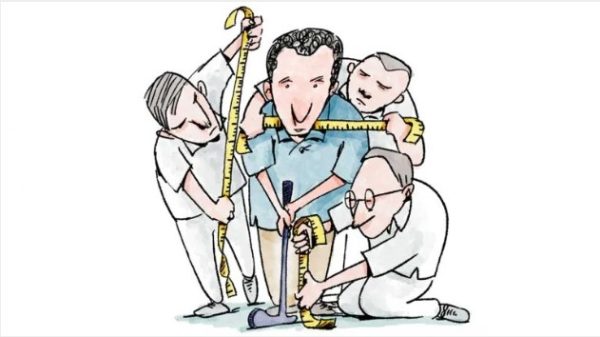Op-Ed: Elizabeth Holmes girlbossed too close to the sun
Ethan Pines/The Forbes Collection; Designed by Vedant Modi
Elizabeth Holmes, and the downfall of Theranos, shines a light on Silicon Valley’s “move fast and break things” culture.
An audacious entrepreneur dressed in all-black, nine billion dollars in value, and one Thomas Edison-esque machine that promised to change the biotechnology market. This is the case of Elizabeth Holmes and the now-defunct Theranos, Silicon Valley’s latest cautionary tale to current and future innovators.
Silicon Valley is an innovation hub; it’s home to major technology companies, including Apple and Alphabet. To startups, the region is a heaven. However, since 90% of startups fail, entrepreneurs have two choices: embrace the region’s “move fast and break things” ethos or get left behind.
Holmes founded Theranos in 2003 and dropped out of Stanford as a sophomore the following year to pursue the startup full-time. Theranos, a combination of “therapy” and “diagnosis”, aimed to develop a revolutionary blood-testing machine- the “Edison”. Named after Thomas Edison, the device theoretically would be able to run over 240 tests, from cocaine to cancer, with just one or two finger prick’s worth of blood.
A decade later in 2013, Holmes and Walgreens announced a long-term partnership. Theranos and Holmes continued to soar for the next two years: Forbes recognized Holmes as one of America’s richest women, investors poured in hundreds of millions of dollars, and the FDA approved Theranos’ Herpes test.
However, what goes up must come down, and Theranos’ success came to an abrupt stop in 2015 after The Wall Street Journal revealed that the company used its technology for only a small batch of testing. From there, investors pulled out and sued, Holmes was indicted on federal wire fraud charges, and Theranos dissolved. In early January, Holmes was found guilty on four charges of defrauding investors.
She moved fast and broke many things in her time as Theranos’ CEO; however, she was still left behind in the end.
Holmes embodied Silicon Valley’s mantra; Theranos sold the future. Blood testing is an integral part of medicine– physicians can check their patients’ cholesterol levels or white blood cell count from blood analysis. However, despite the fact that they play a major role in diagnosis, blood tests are painful and expensive. As someone who despises getting blood tests, the premise of Theranos’ machine was really attractive – Holmes’ machine would replace long needles and multiple vials with a single finger prick. Additionally, her machine intended to cut down the time it took to get lab results back, leading to earlier diagnosis and saving more lives. However, Theranos was just one part of the narrative Holmes painted.
Holmes was the second component in Theranos’ scheme. She entered the tech bubble when it was obsessed with young and humble founders like Mark Zuckerberg and Jeff Bezos, who each started their companies in otherwise average circumstances. Holmes fit this mold well; she was a Stanford dropout with a promising project. Along the way, she intertwined other components to her style to solidify her position as a rising female tech leader. Some people know Holmes for Theranos. Others know her for her outfits and presentation behavior. Holmes is known for copying the late Steve Jobs’ style, dressing in her uniform of a black turtleneck layered under a black suit. Additionally, she rarely blinks when presenting and speaks with a slowly paced, deep, monotonous voice (personally, I want to know if she used this voice in court). Holmes sold herself as the female Steve Jobs and charmed investors. It is clear that Holmes combined her image as a young female entrepreneur and a groundbreaking idea to get the attention that made magazines plaster her face on covers and Theranos skyrocket in popularity.
Theranos serves as proof that in the process of moving fast, the things that are broken include the lives of people. The Journal’s exposé on Theranos revealed that less than 10% of the company’s blood test results were from the Edison machine. Instead, the company used traditional blood-testing machines to run tests. Sometimes samples were collected using needles and large vials; other times, the company would dilute the single drop of blood originally collected to meet the machine’s volume requirement. The results of the tests were, as one would expect, erroneous. From high-enough-to-be-dead potassium levels to false cancer and HIV diagnoses, Theranos performed trial and error on people by allowing its Walgreens testing site to push forward. However, Theranos is not the only company that has produced results at the expense of others’ well-being. While competing against each other to put AI-operated cars on the streets, Uber, Tesla, and Waymo have taken countless lives. Silicon Valley’s beloved mantra has made it a norm to disregard the safety of consumers.
Holmes’ actions have also harmed this generation of female entrepreneurs. Since the downfall of Theranos, many investors have been hesitant to invest in female-founded companies. From publishing research to answering prevention questions, female entrepreneurs now face the pressure of having to constantly prove that their companies will not move in the same path as Theranos. It is already a well-known idea that women are not seen as suitable leaders in the business sector; only 41 women are CEOs of Fortune 500 companies. Holmes’ actions have added to that distrust and will continue to shadow those of female leaders in the future.
However, Holmes was not trying to “break things” intentionally- at least, this is the idea that Theranos’ outside lawyer, David Boies, gave in response to the Journal’s investigation. He said that the ultimate goal of the company was to use the device for a wide range of blood tests and the transition from traditional machines to the Edison was “a journey” the company was on. Their downfall just happened to happen in the midst of that journey.
While I agree that failures are bound to happen when inventing something that will “change the world”, Holmes could have been more transparent with investors. It is a well-known fact that Theranos operated in secrecy, citing “trade secrets” as their reason for not validating claims about Edison’s technology. It’s very common for healthcare companies to release peer-reviewe research, as it allows for not only transparency, but accountability and credibility. In the time that Theranos was running, the company did not publish any papers.
Startups and companies should have peer-reviewed publications before releasing new products to the public. They do not need to release numerous papers, but pieces that contain information with the ability to make a major impact in a field should be shared. This will allow for other professionals in the same field to check over the company’s research and testing to ensure that companies in the future can avoid a collapse like Theranos’. Additionally, patents protect the commercial rights of companies so they do not have to worry about their technology and algorithms becoming available for free, public use. Had Theranos published papers, perhaps professionals in the biotechnology field would have had concrete evidence to prove that creating a machine like the Edison was not possible. Perhaps that would have led to Walgreens halting on their Theranos testing ground, and many people could have been spared incorrect test results.
Holmes currently faces up to 80 years in prison for her four fraud and conspiracy charges. It might be rare to see someone so high in power prosecuted for their crimes, and Holmes’ trial serves as a wake-up call for entrepreneurs in Silicon Valley and beyond. It reminds them that in the case that they choose fraud over failure, they will be held accountable for their actions.
I genuinely believe that Holmes started Theranos off with good intentions; I do not think she was trying to fool anyone. However, somewhere along the way, the failures involved in innovation caught up to her, and she embraced Silicon Valley’s “fake it til you make it” culture. She moved fast and broke many things in her time as Theranos’ CEO; however, she was still left behind in the end.
Your donation will support the student journalists of Carnegie Vanguard High School. Your contribution will allow us to cover our annual website hosting costs and fund field trips, competition fees, and equipment. We appreciate your support!













Laura W • Feb 21, 2023 at 5:07 pm
Such a great and expansive piece! I used this piece to show my writing students how to really dive in to a topic and show all sides.